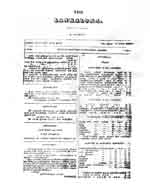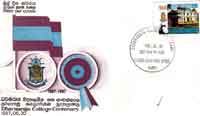The first Sinhala newspaper
Nearly three decades after the publication of an English newspaper, the first Sinhala newspaper made its appearance in June 1860. Although the exact date is not known since it has not been registered with the government, it has been established that 'Lankaloka,' the first Sinhala newspaper commenced publication in June 1860. The newspaper, published in a printing press in Galle Fort (No. 2, Church Street) came out twice a month. Mudaliyar D.W.K. Jayawardena was the promoter of the project. A feature of this newspaper was that the name 'The Lankaloka' appeared prominently while the Sinhala wording was in small print below it. The price of a paper was six pence. (The decimal currency in the present form of Rupees & Cents came into use only in 1872.) The number of pages was four. Most of the space was devoted to advertisements. A column giving information of prices of foodstuffs was published on the first page.
First Buddhist school in the hill capital The leading Buddhist school in Kandy, Dharmaraja College is now 119 years old. It was founded on June 30, 1887 by a group of Buddhist leaders led by Wadugampitiya Nilame at the Natha Devale premises close to the Sri Dalada Maligawa. The establishment of a Buddhist school in Kandy, came on the initiative of Colonel Henry Steele Olcott who started a campaign to set up a network of Buddhist schools as part of the national and cultural reawakening in Sri Lanka. He was keen to expand Buddhist education in the country to counter the influence of Christian missionary activities. Having established an educational fund to help in the setting up of schools, he first opened the Pettah Buddhist Boy's School (it later became Ananda College) followed by Dharmaraja College in Kandy and Mahinda College, Galle. Encouraging Colonel Olcott were scholar monks like Ven. Hikkaduwe Sri Sumangala Thera and Ven. Mohottiwatte Gunananda Thera. Dharmaraja College was initially known as the Kandy Buddhist High School. From small beginnings it soon grew to become a leading educational institution in the hill capital. It mirrored the aims and aspirations of the downtrodden Sinhala Buddhists and prepared the groundwork for the national renaissance by the inculcation of Buddhist and national cultural values in the minds of the students who passed through its portals.
Often Dharmaraja was the starting point for notable Buddhist school principals. Principals of Ananda, P. de S. Kularatne and L. H. Mettanada served as principals of Dharmaraja as well. Among the distinguished old boys of Dharmaraja was the first President of the Republic of Sri Lanka, William Gopallawa (1972-78). He earlier served as Governor-General from 1962. A. E. Goonesinghe who pioneered the labour movement in Sri Lanka was another. Maintaining the highest academic standards, Dharmaraja also took a keen interest in promoting sports and other extra-curricular activities. Significant among these is the winning of the King's Flag for the best Scout Troupe for three consecutive years -1919 to 1921. When the centenary of the College was commemorated by the issue of a stamp on June 30, 1987, it featured the oldest building and the crest along with a portrait of Colonel Olcott.
A Governor resigns Seldom did a British Governor face the ignominy of having to resign before his term of office expired. One such rare occurrence was the resignation of Viscount Torrington who resigned as Governor of Ceylon on June 29, 1850 having served for just three years. From the beginning he had an inauspicious tenure in office. In 1848 several new taxes were imposed. Taxes were levied on dogs (1s on each dog), on guns (2s 6d on each) and on shops, boats, carriages and bullock carts (£ 1 as annual license fee). A stamp tax was introduced but what the people really resented was the road tax when every male between 18-60 years of age, had to work six days a year on repairing or constructing roads. Otherwise a tax of three shillings had to be paid. This led to an uprising in Kandy, Kurunegala and a few other places. The Kandyans really didn't care for roads and they felt the roads were being built to help the planters and other British interests. They treated the tax as a form of 'rajakariya' which had been abolished in 1832. The uprising (it came to be known as the 'Rebellion') began in Dambulla where people gathered under the leadership of Gongalegoda Banda who pretended to be a descendant of King Rajasinghe. The mob reached Matale and plundered the town. When the troubles began to spread, martial law was declared and the Governor asked for soldiers from India. In a week the troops arrived. It took about three months to restore order. Governor Torrington was found fault with for declaring martial law and not handling the situation properly. The British Parliament initiated an inquiry and the result was that Viscount Torrington resigned. He was succeeded by Sir George Anderson.
|
|||||||||||
Copyright © 2006 Wijeya Newspapers
Ltd. All rights reserved. |

